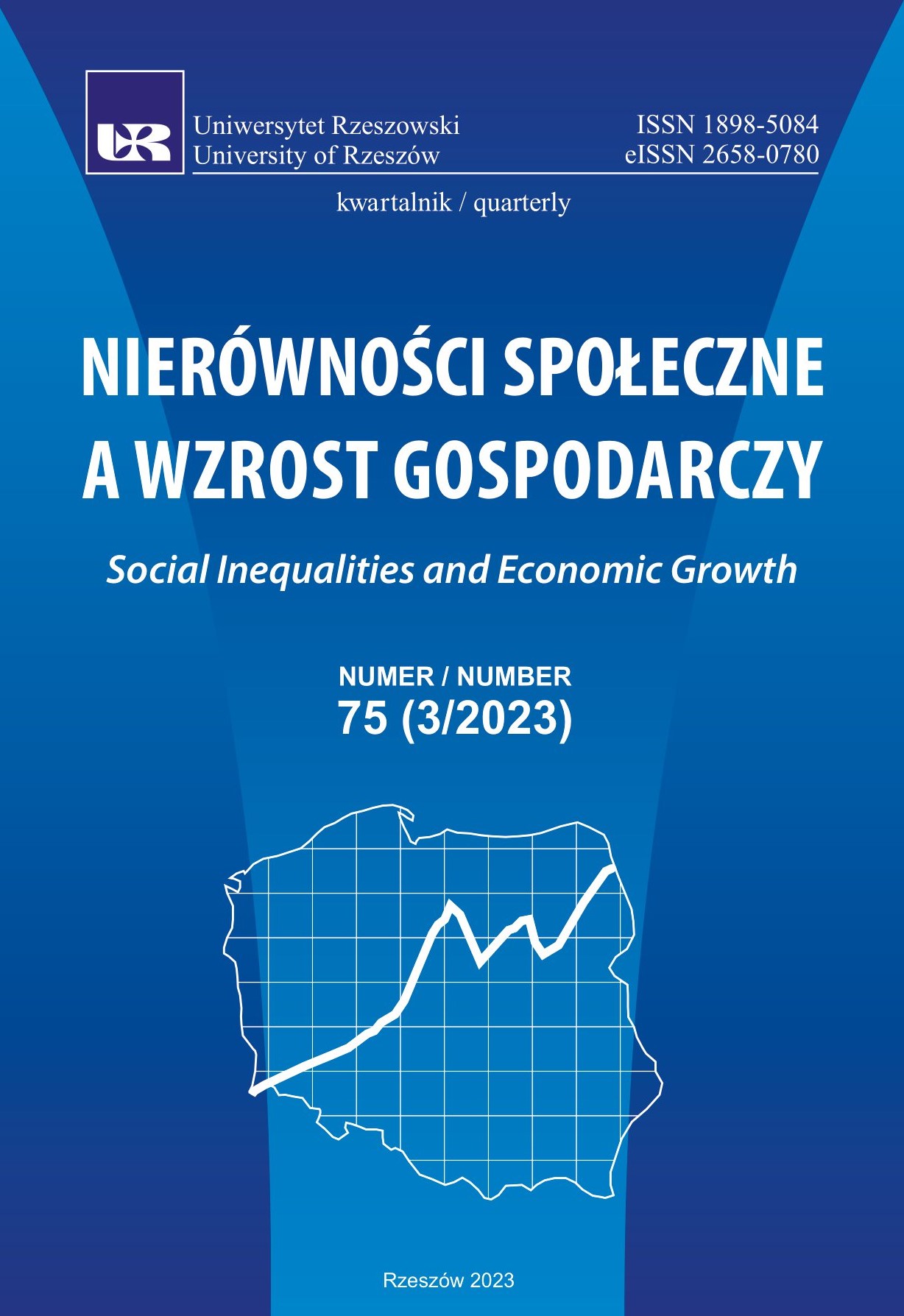The significance of the absorption of EU funds in the socio-economic development of the subregions of Poland, the Czech Republic, and Slovakia
DOI:
https://doi.org/10.15584/nsawg.2023.3.2Keywords:
EU funds, socio-economic development, synthetic gaugeAbstract
Within the EU cohesion policy, higher and lower developed regions, taking into account only GDP per capita, are subcategorised. Based on that, areas qualifying for obtaining support from aid programs of the general EU budget are established. The aim of the article is to attempt to specify the co-dependency between the absorption of EU funds and the changes in the level of socio-ceonomic development in the regional dimension. The research was conducted at the level of 95 NUTS-3 units in Poland, the Czech Republic, and Slovakia in three stages. In the first stage, the level of the development of the subregions in Poland, the Czech Republic, and Slovakia is exhibited, subcategorising three factors of that growth based on 31 indicators: “the society”, “the economy”, or “the natural environment”. In the second stage, the variation in the absorption of EU funds in the researched units is demonstrated. In the third stage, the co-dependencies between the extent of the absorption and the changes in the development within the arrangement of the factors of that development are specified. In the article, a hypothesis is verified according to which the absorption of the EU funds impacted, above all, the development of “the economy” component. As a result of the examination conducted, it has been concluded that the absorption of EU funds impacted the changes in the level of the development of the “economy” sector to the largest extent. It confirms the proper direction of the EU fund intervention, which was made accessible above all to the benefit of the development of that factor.
Downloads
References
Albulescu, C., Goyeau, D. (2014). EU Funds Absorption Rate and the Economic Growth. Timisoara Journal of Economics and Business, 6(20), 25–26.
Baklanov, P. Y. (2020). Geopolitical Factors in Regional Development. Customs Policy of Russia in the Far East, 93(4), 75–83. DOI: 10.24866/1815-0683/2020-4/75-83.
Balcerzak, A. P. (2016). Multiple-criteria evaluation of quality of human capital in the European union countries. Economics and Sociology, 9(2), 11–26. DOI: 10.14254/2071-789X.2016/9-2/1.
Beugelsdijk, S., Klasing, M. J., Milionis, P. (2018). Regional economic development in Europe: the role of total factor productivity. Regional Studies, 52(4), 461–476. DOI: 10.1080/00343404.2017.1334118.
De Castro, E. A., Marques, J., Viegas, M. (2018). The Schumpeter creative destruction hypothesis: A spatial assessment on Portuguese regions. Global Business and Economics Review, 20(2), 198–212. DOI: 10.1504/GBER.2018.090069.
Diebolt, C., Hippe, R. (2019). The long-run impact of human capital on innovation and economic development in the regions of Europe. Applied Economics, 51(5), 542–563. DOI: 10.1080/00036846.2018.1495820.
Dreyer, L. C., Hauschild, M. Z., Schierbeck, J. (2006). A framework for social life cycle impact assessment. International Journal of Life Cycle Assessment, 11(2), 88–97. DOI: 10.1065/lca2005.08.223.
Feldman, M. P. (1999). The new economics of innovation, spillovers and agglomeration: A review of empirical studies. Economics of Innovation and New Technology, 8(1–2), 5–25. DOI: 10.1080/10438599900000002.
Florida, R. (2002). The economic geography of talent. Annals of the Association of American Geographers, 92(4), 743–755. DOI: 10.1111/1467-8306.00314.
Goryachikh, M. V., Kravchenko, L. А. (2020). Free economic zone as a factor of regional economic development. Scientific Bulletin: Finance, Banking, Investment, 2(51), 213–222. DOI: 10.37279/2312-5330-2020-2-213-222.
Jašková, D., Havierniková, K. (2020). The human resources as an important factor of regional development. International Journal of Business and Society, 21(3), 1464–1478. DOI: 10.33736/ijbs.3364.2020.
Khasanova, A., Amirova, N., Sargina, L. (2020). Natural resource potential as a factor of regional development. CITISE, 24(2), 234–245. DOI: 10.15350/2409-7616.2020.2.22.
Krugman, P. (1998). What’s new about the new economic geography? Oxford Review of Economic Policy, 14(2), 7–17. DOI: 10.1093/oxrep/14.2.7.
Matsuura, M. (2015). Contribution of EU Funds to Economic Growth in Poland. Russian and East European Studies, 44, 87–98. DOI: 10.5823/jarees.2015.87.
Naydenov, K. (2019). Human resources development as a factor for regional development. International Multidisciplinary Scientific GeoConference Surveying Geology and Mining Ecology Management, SGEM, 19(5.4), 475–481. DOI: 10.5593/sgem2019/5.4/S23.063.
Nowak, P. (2018). Regional variety in quality of life in Poland. Oeconomia Copernicana, 9(3), 381–401. DOI: 10.24136/oc.2018.019.
Shikverdiev, A. P., Oganezova, N. A., Mazur, V. V., Obrezkov, N. I., Ichetkina, M. A. (2019). Development of regional competitiveness as a factor in creating a favorable business environment. Espacios, 40(28), 1–6.
Spychała, M. (2020). The absorption of EU funds and the socio-economic development in the subregional dimension in Poland. Prace Naukowe Uniwersytetu Ekonomicznego We Wrocławiu, 64(3), 78–91. DOI: 10.15611/pn.2020.3.07.
Yun, J. H. J., Won, D. K., Park, K. B., Yang, J. H., Zhao, X. (2017). Growth of a platform business model as an entrepreneurial ecosystem and its effects on regional development. European Planning Studies, 25(5), 805–826. DOI: 10.1080/09654313.2017.1282082.
Downloads
Published
How to Cite
Issue
Section
License
Copyright (c) 2024 University of Rzeszow

This work is licensed under a Creative Commons Attribution-ShareAlike 4.0 International License.


